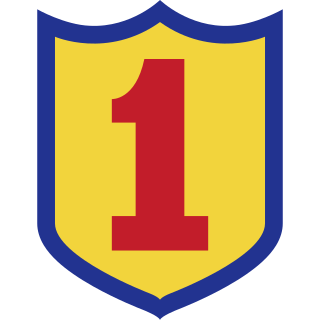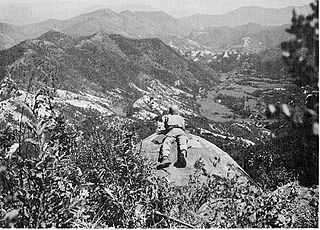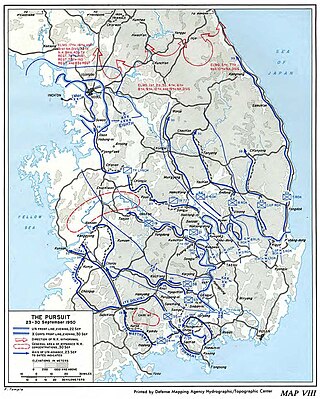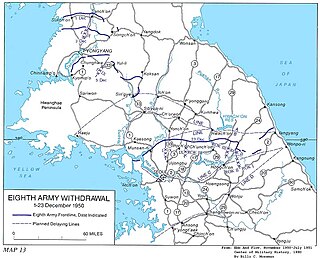
The 1st Provisional Marine Brigade was a marine brigade of the United States Marine Corps (USMC) that existed periodically from 1912 to 1950. It was an ad hoc unit formed for specific operations and not considered a "permanent" USMC unit.

The Battle of the Pusan Perimeter, known in Korean as the Battle of the Naktong River Defense Line, was a large-scale battle between United Nations Command (UN) and North Korean forces lasting from August 4 to September 18, 1950. It was one of the first major engagements of the Korean War. An army of 140,000 UN troops, having been pushed south to the brink of defeat, were rallied to make a final stand against the invading Korean People's Army (KPA), 98,000 men strong.

The 1st Infantry Division is a military formation of the Republic of Korea Army's I Corps. The division was established on 1947 under the command of Colonel Kim Suk-won.

The 3rd Infantry Division is a military formation of the Republic of Korea Army.
The 4th Infantry Division was a military formation of the Korean People's Army during the 20th Century.
The 105th Guards Seoul Ryu Kyong-Su Armored Division is a military formation of the Korean People's Army. It was North Korea's first armored unit and took part with T-34-85 tanks in the Korean War.
The 1st Infantry Division is a military formation of the Korean People's Army.
The 12th Infantry Division was a division of the Korean People's Army during the 20th century. Originally, it was the 156th Division, which was created in November 1948 under the Regulation of the Redesignations of All Organizations and Units of the Army, issued by Central Military Commission on November 1, 1948, basing on the 6th Independent Division, PLA Northeastern Field Army.
The 5th Infantry Division was a military formation of the Korean People's Army during the 20th century. It was activated at Nanam, North Korea, during the early part of August 1949, composed of Korean veterans of the Chinese Communist 8th Route Army's 164th Division, which had been stationed in Changchun, China until July 1949. All non-Korean troops of the 164th CCF Division were transferred to other Chinese Communist organizations in July 1949 and in their place, the division began to receive Korean soldiers from various other units of the Chinese Communist Forces. During the latter part of July 1949, the 164th Division, with a strength of approximately 7,500 men, was allegedly transferred by railroad from Changchun to Nanam, where it was integrated into the expanding North Korean Army and redesignated the 5th Division.
The 10th Infantry Division (Motorized), was a military formation of the Korean People's Army that fought during the Korean War. It was formed at Sukchon in either March or April 1950, raised from a cadre of veteran commissioned and non commissioned officers, and new recruits that were drawn from the 2nd Democratic Youth League Training Center in South P'yongan Province. The unit's original composition is unclear and the division is thought to have been made up of three motorized infantry regiments – the 25th, 27th and the 29th – and an artillery regiment, although some reports, such as those written by the Korea Institute of Military History, state that the 107th Regiment might have been assigned to the division rather than the 29th Infantry, and that there might also have been an armoured regiment attached.

The 2nd Quick Response Division, also known as Furious Wave Division, is a military formation of the Republic of Korea Army and is the only infantry division in the VII Maneuver Corps to serve as an offensive and air assault mission.

The First Battle of Naktong Bulge was an engagement between United Nations Command (UN) and North Korean forces early in the Korean War from August 5–19, 1950 in the vicinity of Yongsan and the Naktong River in South Korea. It was a part of the Battle of Pusan Perimeter, and was one of several large engagements fought simultaneously. The battle ended in a victory for the UN after large numbers of US reinforcements destroyed an attacking North Korean division.

The Battle of Taegu was an engagement between United Nations Command (UN) and North Korean forces early in the Korean War, with fighting continuing from August 5–20, 1950 around the city of Taegu, South Korea. It was a part of the Battle of Pusan Perimeter, and was one of several large engagements fought simultaneously. The battle ended in a victory for the UN after their forces were able to drive off an offensive by Korean People's Army (KPA) divisions attempting to cross the Naktong River and assault the city.

In the Battle of the Bowling Alley , United Nations Command (UN) forces defeated North Korean forces early in the Korean War near the city of Daegu, South Korea. The battle took place in a narrow valley, dubbed the "Bowling Alley", which was north of Daegu. It followed a week of fighting between the Korean People's Army (KPA) 13th Division and the Republic of Korea Army's (ROK) 1st Division along the latter's last defensible line in the hills north of the city. Reinforcements, including the US Army's 27th and 23rd Infantry Regiments were committed to bolster the ROK defenses. This battle and several others were smaller engagements of the Battle of Pusan Perimeter.

The Great Naktong Offensive was a North Korean military offensive against United Nations Command (UN) forces early in the Korean War, taking place from September 1–15, 1950. It was the North Korean Korean People's Army (KPA)'s unsuccessful final bid to break the Pusan Perimeter established by the UN forces.

The Battle of Tabu-dong was an engagement between United Nations Command (UN) and North Korean forces early in the Korean War from September 1 to September 15, 1950, in the vicinity of Tabu-dong, Chilgok County, north of Taegu in South Korea. It was a part of the Battle of Pusan Perimeter, and was one of several large engagements fought simultaneously. The battle ended in a victory for the UN after large numbers of United States Army (US) and Republic of Korea Army (ROK) troops repelled a strong Korean People's Army (KPA) attack.

The Second Battle of Naktong Bulge was an engagement between United Nations Command (UN) and North Korean forces early in the Korean War from September 1 to September 15, 1950, along the Naktong River in South Korea. It was a part of the Battle of Pusan Perimeter, and was one of several large engagements fought simultaneously. The battle ended in a victory for the United Nations after large numbers of United States Army (US) troops repelled a strong Korean People's Army (KPA) attack.

The Pusan Perimeter offensive was a large-scale offensive by United Nations Command (UN) forces against North Korean forces commencing on 16 September 1950.

The UN Forces September 1950 counteroffensive was a large-scale offensive by United Nations Command (UN) forces against North Korean forces commencing on 23 September 1950.

The UN Forces retreat from North Korea was the withdrawal of United Nations (UN) forces from North Korea that took place from 2–25 December 1950.














